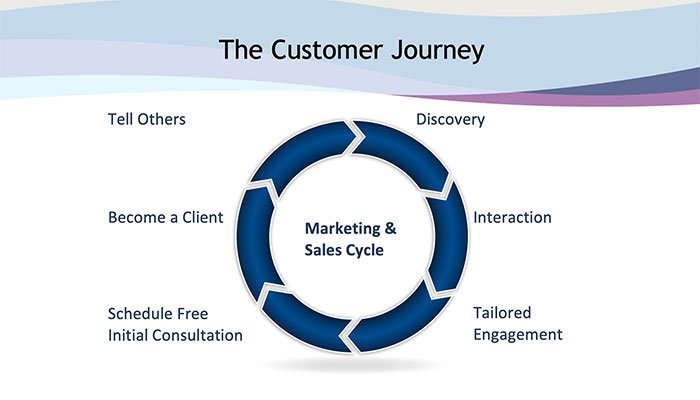
Business 101 will teach you about the marketing and sales process:
- Generating leads. Attracting the attention of as many potential clients as possible (aka, marketing)
- Qualifying the prospects. Who has an immediate need, the budget for your services, and the authority to make the buying decision (aka, sales)
- Closing the sale. Getting the prospect to sign a contract (also sales)
While this describes the goals and activities of the seller, it does not reflect the process from the client’s point of view.
Wooing a customer is a bit like dating
They have to notice you and feel an attraction. You begin with light interactions to build trust. As the relationship deepens, more is revealed, with both parties making decisions about whether this is a good fit or not.
Translated to eldercare
A potential client (or their adult child) might hear of you long before they have an immediate need. Providing opportunities for repeated exposure to your brand allows trust to develop. You build brand loyalty. When their needs change and become more urgent, and/or they have enough trust in your ability to help, they will make the deeper commitment.
Allow small steps
Just as in dating, when you might feel more comfortable going to coffee before you go out to dinner, potential customers like to dip their toe into the water before jumping in with both feet. They are willing to take small risks with their privacy and then with their time before they are willing to commit dollars. If they feel amply rewarded at each step of the journey, they will be more comfortable taking the next step which eventually leads to signing a contract.
Stages of the Customer Journey
- Discovery. They have to find out about you first. This is where you need to present yourself in multiple settings (media) so they can find you with very little trouble. The majority of businesses concentrate their efforts here and neglect the other stages.
- Interaction. The “threshold” most customers pass through in this stage is an email exchange. They send you an email and give up a little privacy—you can now contact them—in exchange for information that hopefully brings them some relief. It’s less risk than a phone number, yet giving you their email address is a critical step. You are no longer just hoping they will notice you. You can now initiate conversations.
- Tailored engagement. As you communicate via email, a potential customer will reveal more about their unique situation if they are prompted by your insightful questions and keen “listening” skills. This is a stage focusing on credibility. You tailor your response such that they gain confidence that you are the best solution to their unique problem.
- Free initial consultation. This is a real-time conversation that is essentially a sales call, so no charge. You are not solving their problem on the spot, but rather describing the services you can apply—assessment, family meeting, consultation—that will lead to a resolution. Giving up their time to have a phone or Zoom conversation is a powerful indicator of readiness to buy. Meeting in person is even more so. You want to remove all barriers for scheduling this meeting. Very few contracts are signed without a real-time conversation first.
- Becoming a client. At some point the conversation will turn to money. This indicates they like what they see and are willing to part with hard-earned dollars. Bravo! The culmination of this stage is when they actually sign a contract.
- Telling others. The cycle does not end with the contract. Presuming they are a satisfied customer, you want to facilitate their ability to tell others about how wonderful it is to work with you. Word of mouth, whether digital or in person, will eventually account for 70% or more of your business. Make it easy for customers to spread the word and authentically feed the discovery process.
Meet your customer where they are
While an eldercare emergency might make for an “accelerated courtship,” most people want to make a considered decision.
Just as you wouldn’t propose marriage on the first date, you need to be sure that you have media and materials that are appropriate for each stage of the journey. Ideally, these materials are geared to appropriately move potential customers from one stage forward to the next.
Do you have the tools you need for each step of the journey?
Learn more about the Customer Journey and
which media are the most effective for each of the stages.
ElderPagesOnline.com/customer-journey-webinar
Questions? Contact Aria Mikkola-Sears, webinars@elderpagesonline.com

